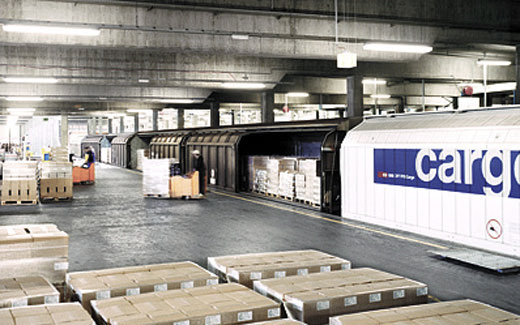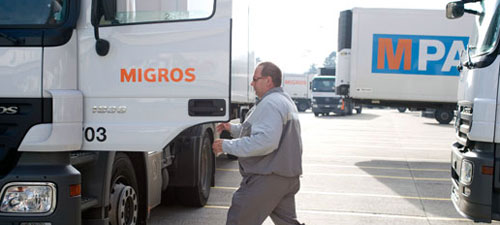
Green Light for Ecology
Transporting goods is a central task in retailing. Migros uses railway operators wherever it can. In 2011 the retailer doubled its efforts to switch overseas transports from aircraft to ships.
Migros has relied on green transport by rail for many years and is expanding its role continuously wherever possible. With more than one million tonnes of freight per year, it is the biggest customer of SBB Cargo in national rail cargo. Virtually all logistics and industrial enterprises have their own rail links. In 2011 the goods wagons of Migros drove a total of approx. 10 million kilometres, 4% less than in the previous year. This fall is, on the one hand, down to milk transports having been shifted to road haulage for price and quality reasons. On the other hand, the national distribution centre in Suhr now supplies shops in its vicinity directly by lorry; this avoids lengthy transport routes via regional operating centres. The production operation Aproz celebrated a special anniversary in 2011: Aproz has transported its mineral water by rail for 50 years. In half a century, Aproz has transported more than 4.2 billion litres of drinks and thereby saved about 20 million litres of diesel or 58'000 tonnes of CO2.
Intermodal traffic strengthened
If transport by rail only is not possible, Migros tries to process the transport by intermodal means. For instance, as of last year a regular shipment of 300 tonnes of onions that used to be imported by truck is loaded onto trains in Hamburg, transported to Basel and then distributed further by road. SBB also upgraded its Sion-Martigny route in Valais in 2011. Aproz' rail connection was therefore not available for about three weeks. Migros also resolved this problem with intermodal transport and thereby prevented an additional burden of more than 350 truckloads.
Air transport shifted
The retailer has recently also been working hard towards shifting air freight transport to ships. As of last year, the principle has applied not to use air transport for near-/non-food products and items from specialist retail centres, and Migros has set itself the target of cutting in half its already small amount of air transport by the end of 2012. Air transport in the areas of food, near-/non-food and specialist markets fell by 10% and stands at 0.6% of the import transports ordered by Migros. For fruit and vegetables, the air freight share is less than 0.5%, but for flowers it is about 30% (weight).
Short cuts on sea tested
Migros tested various innovations in transport and returnable container logistics in 2011, which have a positive ecological effect. As such, certain goods from the Far East were specifically handled via Italian ports. This resulted in shorter transport distances on sea, because the container ships already unload in the Mediterranean, meaning that the detour via Gibraltar to northern European ports is not necessary. Furthermore, northern Italian ports like Genoa are only half the distance from Switzerland as north European ports. Overall, the transport route via Italy is about 4'000 kilometres shorter.
Chart on rail transport kilometrage
Cooperative Retailing and Industry
Truck fleet emissions reduced

The mileage of the in-house trucks was 30.4 million kilometres in 2011, 0.3% less than in the previous year. The consistent upgrading of the company's own fleet with greener vehicles has resulted in a reduction in nitrogen oxide and particulate matter emissions by 39 resp. 47% over the past five years. Today, 78% of the mileage is driven with low-emission exhaust norms Euro 4 and Euro 5. As a significant share of goods is transported by external freight forwarders, Migros has also been lobbying logistics partners to adopt green solutions for several years. In 2011 the retailer organised a sustainability workshop on green and climate-optimised goods transports with its external freight forwarders. Migros has also decided to cooperate only with freight forwarders that use Euro 5 norm vehicles for Migros transports as of mid-2012.
Charts on nitrogen oxide and particle emisssiosn of lorries
1 In-house car fleets Migros cooperatives+Scana
Chart on kilometreage of Euro category lorries
Return system optimised
Migros has successfully used returnable containers in distribution for a long time, for instance to distribute fresh produce from its production enterprises to branches. Key foreign suppliers also use returnable containers. Two partners immediately across the border and one from the US switched from disposable to returnable pallets in 2011. Migros is also continuously optimising its returns systems: the retailer replaced metal grates with plastic folding frames in 2011; they are lighter and, because they can be folded to save space, help to avoid empty trips.